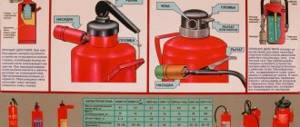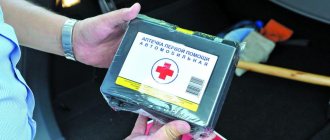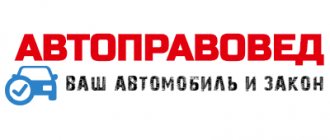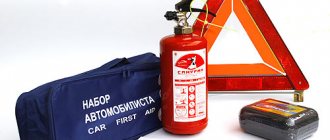Types and shelf life of each
The period of continuous operation of the fire extinguisher is determined by the manufacturer. It is written in the product data sheet. Depending on the cylinder model, the shelf life ranges from 1 to 5 years.
Best before date.
Common devices include the following types:
- Carbon dioxide.
- Freon.
- Chemical.
- Air-foam.
- Emulsion.
- Powder.
According to the principle of influence
The task of the product is to localize the fire as quickly as possible. Existing types differ in the substance contained in the cylinder. It has different physical and chemical characteristics and conditions of use.
Carbon dioxide
The device (OU) is used to extinguish materials that cannot burn without access to oxygen. The cylinder is a red conical cylinder with an installed locking and trigger mechanism and a plastic bell.
The substance pumped inside is carbon dioxide. When ejected, thick white foam is formed with a jet temperature of minus 70 degrees Celsius. If it gets on the hand or other area of the skin, it causes frostbite. Therefore, application requires caution.
Freon
Used in places where it is necessary to store valuables or property. Used in shops, documentary archives, museums.
The advantages of the product include versatility, tracelessness, and efficiency. There is one minus - the harmful influence of freon.
The validity period of a fire extinguisher in a car based on the substance is 5 years. After technical inspection, it can be reused.
Foam/chemical
They represent a reservoir with reagents pumped inside, located in containers isolated from each other. After activating the flask valve and tilting the fire extinguisher, they mix and react to form an extinguishing mixture.
The advantages of the device include:
- release of carbon dioxide, which increases the efficiency of eliminating the source of fire;
- ease of refilling;
- feeding time, jet length;
- long shelf life.
There are many more disadvantages.
These include:
- aggressive substance;
- corrosion of processed objects;
- temperature regime;
- storage under certain conditions.
These characteristics contribute to rare use and are the determining factor in regulating the price.
Air foam
Used to extinguish fires of organic materials and substances that change structure when heated (petroleum products, paints). The solution in the cylinder creates a foam cover that prevents oxygen from reaching the source of fire.
The advantage of the device is its operating time, which significantly exceeds that of other types of auto fire extinguishers.
Air emulsion
OVE cylinders are environmentally friendly and safe. They are used to eliminate the fire of liquid and solid materials, as well as equipment with a voltage of no more than 1000 V. They have a minimum consumption of substances and do not create dust.
The shelf life of a car fire extinguisher is 5 years.
Powder
Used to eliminate fires of hot materials, liquids and petroleum products. Also used to localize fires in cars or trucks.
Powder fire extinguishers.
The advantages of a powder device (PD) are:
- no temperature restrictions;
- high efficiency.
There are practically no disadvantages. The main disadvantage is pollution. Small particles of the injected material scatter to the sides and settle on the surface.
The shelf life of a powder fire extinguisher for a car is 5 years. After expiration, the device is sent for technical inspection.
Water
Devices based on this material effectively eliminate the combustion of solid and organic substances. They are ideal for localizing smoldering objects such as paper, rags, wood. Not for use in case of fire of liquids. Completely safe. The main disadvantage is the inability to use at low air temperatures.
By charge mass
Models are classified as follows:
- Up to 20 kilograms. These include small portable models used in offices and premises.
- From 20 to 450 kilograms. Mobile options used at metro stations or gas stations.
- Above 450 kilograms. Stationary models included in the automatic fire extinguishing system.
By body volume
The cylinder capacity of modern devices can be:
- Up to 5 liters – low-sized manual models.
- 5 - 10 liters - industrial use.
- 10 liters and more - large mobile or stationary models.
The effect of the pumped fire extinguishing agent does not depend on the capacity of the cylinder. The difference between the options lies in the internal pressure, which is checked using the installed pressure gauge.
Types of fire extinguishers for cars
Today, it is customary to use two main types of fire extinguishers in cars - carbon dioxide or powder. Each type has its own characteristics, as well as important advantages and disadvantages.
Powder (OP)
This type of fire extinguisher is filled with a special powder that can block the access of oxygen to the source of fire.
The pressure inside the cylinder can be created in different ways, as evidenced by the corresponding markings on the device:
- “G” - with a gas-generating cartridge;
- “Z” - download;
- “B” is a gas cylinder that is under pressure.
It is important to note that fire extinguishers marked “Z” and “B” fire with a delay that can reach 5 seconds.
OPs are capable of extinguishing a fire of any complexity, preventing a re-ignition. Moreover, the price of such devices is more affordable compared to carbon dioxide fire extinguishers.
But powder cylinders also have their disadvantages. In particular, the powder that eliminates the source of fire heavily contaminates the surface and is very difficult to wash off.
Carbon dioxide (CO)
The main active ingredient in this case is carbon dioxide (CO2). When charging the fire extinguisher, carbon dioxide is compressed to the maximum, so additional pressure is not required.
A powerful jet of carbon dioxide can effectively put out a fire and lower the temperature at the source of the fire. After using the OC, the vehicle owner will not need to wash the car from foam.
However, this type of fire extinguisher also has its significant disadvantages, which include:
- possibility of carbon dioxide poisoning;
- the appearance of burns due to careless or improper use;
- strong recoil that can knock the fire extinguisher out of your hands.
An important disadvantage is the cost of the device, which is 2-3 times higher than the price of powder fire extinguishers.
Which fire extinguisher to choose for a car
When considering a vehicle device model, you need to build on the existing requirements:
- The mass of the substance in the housing is at least 2 kg.
- In accordance with existing standards of 2018-2019, devices used in machines can only be carbon dioxide or powder. Other options are excluded.
- When buying a cylinder or first aid kit, ask for a certificate and passport. They will be required during verification by the relevant service.
- Consider the thickness of the housing walls. A good option is a steel model. Other products are less reliable.
Regarding the question of how to determine the expiration date of a car fire extinguisher, everything is simple here. It is usually applied on the label in a specially designated place.
Do you need a fire extinguisher in a car?
The number of vehicle owners increases every year. Fortunately, the majority of these people have only heard that a car can catch fire for some reason. For example, due to a malfunction in the electrical system. But this happens quite rarely. Therefore, most often citizens live with the firm belief that providing a car fire extinguisher for technical inspection is an additional burden, and not a vital necessity.
Fortunately, there are quite a few drivers who actually had to witness a car burning or even participate in extinguishing it. The availability of a working means of fighting fire and the ability to use it is beyond doubt among this category of road users. It's a sad experience. Therefore, they know for sure that when buying a fire extinguisher for a car, the requirements of 2021 must be taken into account.
Even fewer owners have cars that have burned out and are now scrapped. And they are firmly convinced that:
- trouble in the form of a fire can happen to any car;
- the shelf life of a car fire extinguisher for technical inspection is important, but even more important is the possibility of using it, if necessary, for its intended purpose;
- According to statistics, a passenger car burns out in 15-20 minutes;
- Having a car fire extinguisher, complying with the requirements for it and knowing how to use it is the only option for localizing a fire.
It is important to know! Thus, if we make allowances for the traditional Russian “maybe it won’t affect me,” motorists no longer express doubts about the need to have a fire extinguisher in their car. But at the same time, the main criterion for choosing it is most often the price. The task of specialists is to convey to the buyer that the consumer properties and technical capabilities of this specific product are more important than its cost. By the way, not very high.
Regulatory requirements for maintenance
Any fire extinguishing products and first aid kit must comply with a number of emergency situations factors.
The current ones are:
- Compliance with GOST NPB 155-2002, as well as R51057-2001.
- The amount of pumped substance for trucks is 5 liters, for passenger vehicles - at least 2 liters.
- The period of possible use of a fire extinguisher is also important. The closer to its end, the less internal pressure. This needs to be monitored. When the pressure gauge drops below the permissible limits, the cylinder is sent for recharging.
- Labeling must include information about the manufacturer.
Requirements for a car fire extinguisher
The Fire Safety Code strictly states that a car fire extinguisher with a capacity of at least 2 liters must undergo technical inspection. The same document does not specify in what case it should be submitted. But it is better to give preference to metal.
- The fire extinguishing device must have a passport and a certificate of origin.
- If it has not yet been used, its receipt must be sealed.
- Of course, the device itself must be in good working order, and the service life of the car fire extinguisher should not end.
If all these conditions are met, the inspector will not be able to find deficiencies in fire safety requirements.
Stamp on the check
Car storage rules
Rules for storing in a car.
The placement of the fire extinguisher must comply with a number of standards:
- Placing the device in the trunk of a car is prohibited. If there is a sudden fire, you may not have time to remove it.
- The storage area for the cylinder is protected from direct sunlight.
- The fastening must be reliable. Contact of the housing with other elements is unacceptable.
Which car fire extinguisher is used for what type of transport?
- In passenger cars and Gazelles, devices with a volume of 2 liters are used: either powder or carbon dioxide.
- In trucks - either OP or OU with a capacity of 5 liters only.
- For fuel tankers, the requirements are as follows: two 5-liter tanks.
- Small class buses are equipped with two 2 liter fire extinguishers.
- In large buses: one in the driver's compartment with a capacity of 4 liters, in the passenger compartment with a capacity of 2 liters.
If the fire extinguishing device is located outside the passenger compartment, it must be protected from sunlight and natural precipitation.
Fire extinguisher on the bus
Precautionary measures
In accordance with the 2021 regulations, the car must have at least one fire extinguisher, first aid kit, and car kit.
Their storage involves a number of rules, including:
- If a defect or malfunction of any mechanism is detected, the cylinder must be sent for an unscheduled inspection.
- The fastening is reliable. Any shock, impact or other damage may damage the device or cause it to operate unintentionally.
- Placement in direct sunlight or near heating elements is prohibited. Increasing the temperature of the injected material above + 50 degrees Celsius can spoil it.
How to choose a fire extinguisher for a car?
Price, of course, matters, but it is not the main criterion when choosing a fire apparatus.
It is important not only to follow the requirements of traffic police officers, but also to remember that a fire extinguisher can save lives and property. Quality and ease of service should come first.
Tips for choosing a fire extinguisher for your car:
- Buy the device only in specialized stores and ask the seller for all the necessary documents and certificates for the product.
- Before purchasing, check the parameters of the fire extinguisher that is suitable for your vehicle.
- Consult experts at point of sale. They will help you make the right choice and understand the nuances.
- There should be no scratches, dents, corrosion or damage on the device.
- Check the expiration date of the device and seals.
- Check the operation of the pressure indicator.
- After purchase, carefully read the operating instructions.
Remember to check the expiration date as you use it. An expired fire extinguisher will not work in an emergency and can lead to catastrophic consequences.
The fine for an out-of-date fire extinguisher in a car is 500 rubles; you will pay a similar amount for the lack of fire safety equipment (Article 12.5 of the Code of Administrative Offenses).
Fire extinguisher inspection procedure
Carrying out simple measures after purchasing a fire extinguisher will give you confidence that in an emergency it will fulfill its purpose. They include:
- In the store you should check the contents, the availability of accompanying documentation, refueling marks and the time of subsequent inspection.
- By external inspection, determine the integrity of the product components.
- Determine a place to place the fire extinguishing device, with convenient access and easy activation.
- You need to carefully study the operating instructions, understanding the optimal conditions of use (starting order, required distance to extinguish the flame, etc.).
Timely condition monitoring and maintenance will allow timely identification and elimination of deficiencies in fire equipment.
Checking fire extinguishers is represented by visual inspection and metrological actions:
- identification of dents, scratches of the case, control devices;
- violation of the paint and protective layer of the surface;
- the formation of corrosion that prevents the release of the fire extinguishing mixture;
- seal sealing the fuse against accidental start-up;
- validity period of the fire extinguisher in the vehicle;
- good condition of informing devices (pressure gauge, etc.), if any;
- pressure limitation stamp;
- determine the actual mass of the product, and the proportion of the extinguishing agent in it;
- if there is an extension hose, its condition.
The use of fire extinguishers that, in terms of their technical characteristics, do not comply with the stipulated standards, do not have inspection markings, the expiration date of the fire extinguisher has passed, or obvious mechanical damage has been detected is not allowed.
Classification of fire extinguishers
The modern market can offer the following types of fire extinguishers:
- Powder (labeled OP, and the index shows the mass of the charge (OP 4 - 4 kg, OP 5 - 5 kg). A powder fire extinguisher is a universal device that is applicable for any type of fire, including fires in cars. The main extinguishing agent for This type of fire extinguisher is powder.According to the method of jet emission, powder fire extinguishers are divided into injection (Z), gas generator (D), compressed air cylinder (B).
- Air foam (ORP marking). They have 2 types of active ingredients: air-mechanical - the foam consists of water and a foaming agent, and chemical - the foam is formed from a mixture of water and alkali.
- Carbon dioxide (OU marking). The index also shows the mass of the charge in the cylinder (OU 2 - 2 kg). The active substance in carbon dioxide fire extinguishers is carbon dioxide (under pressure, which varies depending on the ambient temperature).
- Water (labeled OTV). Accordingly, the active substance in such a fire extinguisher is water.
- Self-activating modules (OSB marking). The active substance in such a fire extinguisher is powder.
Ipc-zvezda.ru
It is recommended that before purchasing a fire extinguisher, you check the device for each of the following points:
- Each fire-fighting device must comply with two GOST-NPB 155-2002 and R51057-2001.
- A type of extinguishing agent.
In 2021, two types are allowed: carbon dioxide and powder. - Correct labeling.
A high-quality fire extinguisher will indicate all the basic information from the composition of the extinguishing mixture to the instructions for use. - Lifetime. Over time, a fully charged fire extinguisher will lose a significant part of the pressure and important properties of the extinguishing mixture.
- Everything about car operation
- What kind of fire extinguisher is needed in a car according to the 2018 rules?
- Fire extinguisher for a car - what are the requirements in 2018?
Fire extinguisher for a car - what are the requirements in 2021?
- RuskyKupec › Blog › Which fire extinguisher should be in a car
- What fire extinguisher should you have in your car in 2021?
- Fire extinguishers for cars and requirements for them
requirements for a fire extinguisher in 2021 src=» «=»» alt=»Requirements for a fire extinguisher in a car 2018″ Fire extinguisher for a passenger car - requirements Powder fire extinguishers have a number of disadvantages: They do not create a cooling effect that protects against re-ignition.
Cost of powder fire extinguishers 2 liters 250-300 rubles 3 liters 350-420 rubles 4 liters 460-500 rubles 5 liters 550-600 rubles Cost of carbon dioxide fire extinguishers 2 liters 450-490 rubles 3 liters 500 rubles 5 liters 650 rubles 8 liters 1000 rubles 10 liters 2800 rubles Buy a fire extinguisher for your car by visiting the following stores in person or by ordering online:
- Bigam.
- WOW.
- LLC Trend Rus.
- MAXIDOM.
- Vam-shina.
- Sathro-Paladin.
- ToyWay.
- Trends4Car.ru.
Penalties provided for by the legislation of the Russian Federation Traffic police officers impose penalties in two cases:
- when driving without a fire extinguisher;
- when there is an expired fire extinguisher in the car.
The fine is imposed in accordance with Article 12.5 of the Code of Administrative Offenses. It states a fixed amount of 500 rubles.
Each fire extinguisher indicates the expiration date, the date the mixture was checked, and the time for refueling or refilling.
When using a fire extinguisher, the car owner must check its expiration date from time to time.
The fire extinguishing device may not operate after it expires, which will entail unpredictable consequences if a fire occurs.
The traffic police authority will subject the car driver to administrative sanctions if the device expires.
It is expressed in the imposition of a fine in the amount of 500 rubles, which is established by the standards of Article 12.5 of the Administrative Code. Important nuances Any failure to fulfill driving duties entails the application of sanctions in accordance with the instructions of Article 12.27 of the Code of Administrative Offences. These reasons include:
- Fire of fuel liquid due to poor sealing of tubes in the fuel system;
- Electrical wiring shorted;
- Deliberate arson.
When approaching extinguishing a possible fire in a car more scrupulously, it is important to note that you should have a fire blanket in your car - this is a special non-flammable fabric of a large area that prevents air from reaching the burning object. This also applies to special-purpose equipment that is needed to extinguish a fire.
But in this material we will look at a fire extinguisher for a car and the requirements that apply to them in 2021.
Requirements The list of requirements that must be met for automobile fire extinguishers was developed a couple of years ago by two departments: Rospozhnadzor and the Ministry of Emergency Situations.
If, due to the fault of the driver, an emergency situation occurs on the road and he does not take certain measures, then an administrative fine in the amount of 1,000 rubles is imposed on him.
For example, he will not stop the car or display an emergency sign.
For driving a car without a Certificate of registration with the State Traffic Safety Inspectorate, in accordance with the standards of Article 12.3 of the Code of Administrative Offenses, an administrative penalty is imposed. It is presented in the form: Indicators Description Warnings - A fine in the amount of 500 rubles Seizure of a car with its subsequent evacuation to a impound lot If the registration procedure was not carried out within the established time frame, then a fine of 500-800 rubles is imposed, which is emphasized in the article 12.1 Code of Administrative Offences.
Checking and recharging fire extinguishers
When purchasing an extinguisher, it must have the following components:
- a cylinder made of metal;
- passport with manufacturer's marks;
- working pressure sensor;
- safety pin secured with a seal;
- socket - a spray nozzle through which the extinguishing agent comes out.
The purchased fire extinguisher must indicate its expiration date. The shelf life of a metal cylinder is usually 10 years for powder extinguishers and 15 years for carbon dioxide extinguishers. But they need to be checked every year. Both types of car fire extinguishers need to be fully refilled every 5 years. Operating conditions are described in detail in the set of rules SP 9.13130.2009 “Fire fighting equipment. Fire extinguishers. Requirements for operation."
When recharging, the cylinders are subjected to a hydrostatic pressure test to check their integrity. Then the cylinders of powder and carbon dioxide fire extinguishers are dried. The presence of moisture in them is not allowed. Only then are extinguishing agents pumped in. After completion of the inspection and refilling, the fire extinguisher is marked with the appropriate marking, which indicates: the date of inspection or refilling, the name and address of the company that performed the work.
It should be borne in mind that during vehicle inspection, fire extinguishers are weighed and checked, while inspecting:
- integrity of the protective coating;
- condition of the flexible hose and sprayer;
- fuse seal;
- presence of stamps and markings;
- pressure meter.
Recharging fire extinguishers - video
Do not take lightly the fire extinguishing devices that should be in the vehicle. It is necessary to constantly remember that a technically serviceable fire extinguisher can save not only a car, but also human lives from a fire. To do this, it must be in an easily accessible place so that the fire extinguisher can be quickly used by the driver or passengers.
The article was written based on materials from the sites: sovets.net, ruslanhasanov.ru, www.drive2.ru, yurist-online24.ru, avtozakon.guru.
Is it possible to use an expired fire extinguisher?
Due to safety precautions, an expired fire extinguisher of any type must not be used. Automotive fire extinguishing devices with expired service life may cause the vehicle to fail a technical inspection. The use of expired fire extinguishers is potentially dangerous due to the following circumstances that may arise when it is necessary to extinguish a fire:
- failure and impossibility of its operation;
- change in effectiveness due to loss of fire extinguishing agent properties.
REFERENCE! Expired fire extinguishers can be used as a training tool. Such cylinders are used for training in fire classes and at enterprises when studying safety precautions and practicing fire extinguishing skills.
Fire safety standards prohibit the presence within the walls of an enterprise or institution of any type of fire extinguisher that has expired and has not passed mandatory inspection.










